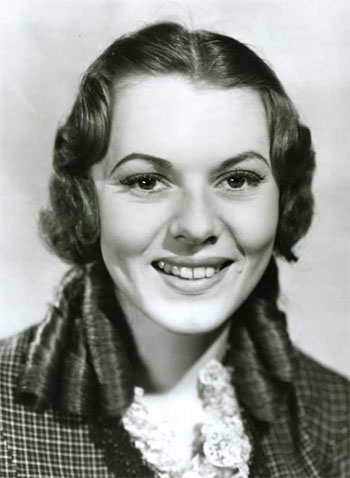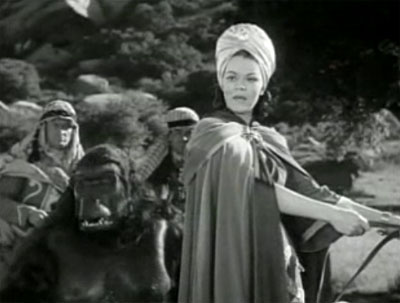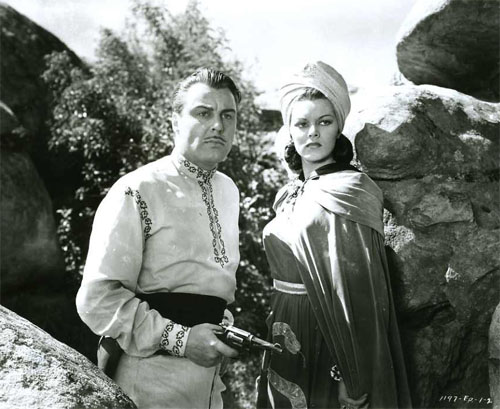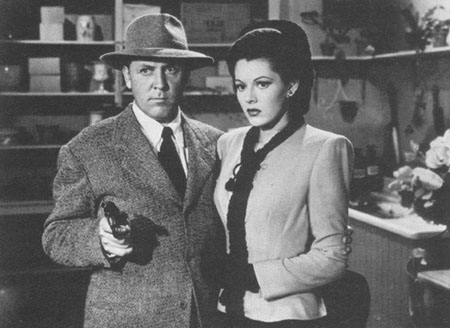July 26th, 1918 — April 30th, 2017

Above: A late 1940s Republic Pictures publicity photo of Lorna Gray, who by that time was being billed as Adrian Booth.
Lorna Gray was charming, graceful, and strikingly beautiful; she was also an extremely versatile actress, one who could play ruthless villainesses as well as she could sweet- natured heroines. Her versatility eventually caused Republic Pictures to promote her from serials to their bigger-budgeted films, a distinction few of the studio’s other cliffhanger heroines received. Because of her excellent performance as the evil Vultura in Republic’s serial Perils of Nyoka, cliffhanger fans tend to remember Lorna Gray chiefly as a villainess. However, she also played the heroine in four other serials, so her skill at villainy shouldn’t be allowed to overshadow her status as one of the cliffhanger’s best and most frequent leading ladies.
Lorna Gray was born Virginia Pound in Grand Rapids, Michigan. She became interested in acting at an early age, briefly working as a professional singer during her teenage years. After finishing high school, she won two local beauty pageants, and soon afterwards took on a short-lived singing engagement in Chicago. She then made her way to New York, where she worked as a waitress before joining comedian Ben Yost’s vaudeville show, where she was discovered by a Hollywood talent scout. She came to Hollywood in 1937, working in bit roles till 1938, when she played the heroine in the John Wayne B-western Red River Range for Republic Pictures. The same year, she became a contract player at Columbia Pictures, beginning her career there as the leading lady in the Foreign Legion B-film Adventure in Sahara. For the next several years, she became a very familiar face in Columbia’s B-movies, appearing in the studio’s B-westerns, mysteries, horror films (including the Boris Karloff vehicle The Man They Could Not Hang) and comedy shorts (including the Three Stooges’ Three Sappy People and Buster Keaton’s Pest from the West). As she put it in a 1997 interview with Joe Collura in Cliffhanger magazine, “I was down in Columbia’s casting office all the time. ‘Please, can I have a part? May I do something?'” It was inevitable that Columbia would put the hard-working young actress in a serial sooner or later, and they did just that in 1939.
This 1939 cliffhanger was Columbia’s energetic if erratically-plotted thriller, Flying G-Men. The cliffhanger dealt with a masked aviator called the Black Falcon and his fight against a sinister ring of spies and saboteurs. The Falcon was the creation of a group of four G-men, ex-flying-aces who selected one of their number to assume the guise while the other three agreed to back him up. Lorna Gray played Babs McKay, the sister of the G-men’s inventor friend Ed McKay; her role in Flying G-Men was not a large one, as she had to share screen time with three different heroes (the fourth G-man was killed off early in the game) and juvenile lead Sammy McKim. She made a very appealing heroine nonetheless and worked well with her leading men, two of whom (Robert Paige and James Craig) would later move to bigger features, just as Lorna eventually would.

Above: Lorna Gray and the mysterious Black Falcon in a publicity still for Flying G-Men (Columbia, 1939).
Lorna continued to co-star with actors ranging from cowboy hero Charles Starrett to comedian Charley Chase in Columbia’s B-movies and shorts, before being cast in her second serial, 1940’s Deadwood Dick. This Western chapterplay starred Don Douglas as Dick Stanley, a gunfighter turned newspaper editor who strapped on his guns again and assumed the guise of the masked cowboy “Deadwood Dick” to battle a gang of outlaws led by the mysterious “Skull.” Gray again played the sister of a murdered good guy, although her role was much larger than in Flying G-Men. This time, her character was Ann Butler, sister of a reporter killed by the Skull in Chapter One. Ann took over her brother’s position on Stanley’s paper, and aided both Stanley and Deadwood Dick in their battles with the Skull. She continued to provide Stanley with valuable assistance after finding out, about halfway through the serial, that he was in fact Deadwood Dick. Deadwood Dick, made during a period when most Columbia serials were almost self-parodies, was surprisingly exciting and involving, with a strong cast and plenty of action. Though Lorna later admitted (in the aforementioned Joe Collura interview) that she disliked making the serial, due to several potentially dangerous action scenes she had to perform without a double, none of her discomfort showed on the screen, and she delivered a likable and spirited performance.

Above: A publicity still of Lorna Gray in Deadwood Dick (Columbia, 1940).

Above: Don Douglas and Lorna Gray in Deadwood Dick
Gray’s Columbia contract expired shortly after Deadwood Dick, and the studio didn’t renew it. She then began to freelance, appearing in several Monogram B-pictures and in the Republic B-musical Tuxedo Junction (1941), in which she played in support of the comic “Weaver Family.” The next year, Republic rehired her to appear in their serial Perils of Nyoka. A fast-moving, colorful, and action-packed cliffhanger, Nyoka was set in the North African desert, and starred Kay Aldridge as Nyoka Gordon, a young woman looking for her missing scientist father. Clayton Moore co-starred as the heroic Dr. Larry Grayson, while their opposition was headed by Lorna as the vicious Vultura, an Arab ruler vying with Nyoka, Larry, and their expedition for the lost Tablets of Hippocrates. The expedition wanted the tablets for their medical value, while Vultura was seeking them for the sake of the treasure hidden with them and didn’t care a straw for curing illnesses. With the help of her band of Arabs and her pet ape Satan (Emil Van Horn), the desert queen made a lot of trouble for the good guys, until she finally met her a violent last-chapter comeuppance. Up till now Gray had had little experience in anything but ingenue roles, but she made Vultura highly menacing, delivering her lines with an arrogant sneer, smirking evilly when submitting poor Nyoka to various torments, and convincingly bossing her crew of henchmen, which included far more experienced heavies like Charles Middleton and George J. Lewis. Perils of Nyoka remains one of Republic’s best-remembered serials, and Lorna’s Vultura will always be one of the studio’s best-remembered villains.

Above: Vultura (Lorna Gray), flanked by her henchmen and the mighty gorilla Satan (Emil Van Horn), prepares for evildoing in Perils of Nyoka (Republic, 1942).

Above: Tristram Coffin and Lorna Gray in Perils of Nyoka.
Gray appeared in a few other features, chiefly Republic outings, and then returned to serials with Captain America (Republic, 1944). This time she was a heroine again– Gail Richards, secretary to District Attorney Grant Gardner (Dick Purcell) and confidant to his alter ego, Captain America. Gardner used the Captain America guise to give battle to the Scarab, a madman targeting a group of famous scientists for murder; eventually he and Gail unmasked the Scarab as museum curator Dr. Maldor (Lionel Atwill), who was seeking revenge on former colleagues that he felt had ruined his career. While this serial bore scant resemblance to the comic book it was based on, it was an incredibly fast-paced and action-filled effort, with strong performances from hero Purcell and villain Atwill. Gray’s performance was also a good one; she received a lot of screen time, and added a touch of warmth to her efficient, businesslike character, chiefly by showing convincing horror at the Scarab’s lethal rampages and convincing concern for Captain America’s safety.

Above: Dick Purcell and Lorna Gray in Captain America (Republic, 1944).

Above: John Davidson (left) and Lionel Atwill are planning to turn Lorna Gray into a mummy via some poisonous gas in Captain America.
After a few more Monogram and Republic features, Gray made her fifth serial, Federal Operator 99 (Republic, 1945). This cliffhanger cast her in another villainous role– Rita Parker, the girlfriend and accomplice of the sophisticated, piano-playing master criminal Jim Belmont (George J. Lewis). The larcenous pair were adept at heists of all descriptions, but were finally brought to bay by federal agent Jerry Blake (Marten Lamont). Federal Operator 99 was an unspectacular but thoroughly satisfying cliffhanger, with a varied array of capers, some distinctive action scenes, and uniformly good acting. As in Nyoka, Gray again delivered a memorably mean performance, though her Rita was not as cunning as Vultura had been; her brassily self-confident characterization contrasted nicely with Lewis’ urbane chief villain.

Above: Lorna Gray looks pensive while George J. Lewis plays the Moonlight Sonata in Federal Operator 99 (Republic, 1945).
In 1945, Republic Pictures’ boss Herbert Yates signed Gray to a contract, having been impressed by the range of her acting talent. In the process, her name was changed to Adrian Booth, and the studio began grooming her as a studio “discovery.” Before moving on to more prestigious features, she appeared in one more serial under her new name, getting top billing for the first and last time in her cliffhanger career. The briskly entertaining serial Daughter of Don Q (Republic, 1946), featured Gray (or Booth) in the title role, a wealthy socialite and sportswoman named Dolores Quantaro. Dolores was one of several descendants of an Spanish Californian nobleman, and among her unknown relations she unfortunately numbered one Carlos Manning (LeRoy Mason). Manning discovered an old Spanish grant that awarded a now-valuable tract of land to the Quantero heirs, and he set out to eliminate all the other Quantero descendants with the help of his henchman Donovan (Roy Barcroft). Dolores dodged Manning’s murder attempts and joined with wise-cracking reporter Cliff Roberts (Kirk Alyn) to thwart the villain’s schemes. Gray did an excellent job of making her character seem at once passionately worried about the peril to her relatives and cheerfully enthusiastic about her amateur detective work; she also managed, with the coaching of stuntman David Sharpe, to make her character’s supposed athletic abilities (including jiu-jitsu and archery) seem believable enough.

Above: Kirk Alyn and Lorna Gray in Daughter of Don Q (Republic, 1946).

Above: Kirk and Lorna in another still from Daughter of Don Q.
Under her new screen name, Lorna was paired with Republic’s new cowboy star Monte Hale in a series of rather highly-budgeted B-westerns that ran from 1946 to 1947. When the Hale series failed to meet Republic’s expectations, Gray was moved into A-westerns in 1948. The same year, she married actor David Brian; the pair would remain together till Brian’s death in 1993. Lorna’s Republic A-westerns included The Gallant Legion (with William Elliott), Brimstone (with Rod Cameron and Walter Brennan) and Rock Island Trail (with Forrest Tucker). Her last Republic film was The Sea Hornet, a non-Western mystery in which she reverted once more to villainous mode, playing a duplicitous nightclub singer. Her final film was the 1951 Monogram sea drama Yellow Fin, after which she retired to private life. In 1952, she began a long career in Christian charitable work, founding the adoption agency WAIF along with Jane Russell. She spent the rest of her long life in California, graciously maintaining contact with movie and serial fans, and making occasional public appearances at film conventions. She passed away in the spring of 2017, a few months short of her hundredth birthday.
Lorna Gray’s oscillation between sympathetic and unsympathetic parts prevented her from becoming an iconic “serial queen” like Kay Aldridge or Linda Stirling, but she was definitely one of the most likable heroines of the sound serial era, just as she was one of its nastiest villainesses. Whether playing heroine or villainess, whether billed as Lorna Gray or Adrian Booth, she was lovely, believable, and a pleasure to watch.

Above: A publicity shot of Lorna Gray at Republic Pictures early in her post-serial career, on the set of the Monte Hale film Home on the Range (1946).
Acknowledgements: The above-mentioned Joe Collura interview with Lorna Gray provided me with the biographical information in this article.
I can’t figure out why, as Captain America’s sidekick, through all the episodes, her clothing never changed.
She has a brief scene in “Mr. Smith Goes To Washington”. She’s one of the fundraising ladies at the train station.
Talented and glamorous, she was indeed “lovely, believable and a pleasure to watch”. Whether it was as Vultura, Gail Richards, Rita Parker or any of her other serial roles, her presence was always an asset to the films. It’s no wonder that Republic chose to feature her in higher-budgeted productions. Her performance as Vultura is particularly entertaining. She’s commanding, evil, imperious and extremely sexy as well. Quite a contrast to the studio’s typically attractive, but exceedingly bland female leads.
I see her as being similar to Jan Wiley, in that she also would have done well in the darker post-war “film noir” genre. She did a few films where her characters bordered on that type of role, and always excelled, but that sort of thing really wasn’t Republic’s style. Again, as with Jan Wiley, she chose another path in life.